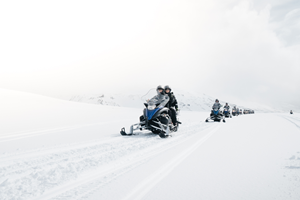ABOUT GLACIERS IN ICELAND
Iceland's glaciers cover about 11.1% of the country's area. These large masses of ice slide down the slope in the shape of a tongue and have a great capacity for movement. Many of the glaciers in Iceland have formed on still active volcanoes, which makes them have special characteristics. When these volcanoes erupt, the ice on the glacier that covers them melts very quickly and a phenomenon occurs that Icelanders call “jökulhlaup”, which means a sudden and devastating flood.
The future of glaciers is in danger because of greenhouse gases that makes glaciers gradually disappear, recent studies confirm that glacier cover in Iceland down 18% in 130 years.
HOW ARE GLACIERS FORMED?
A glacier is a compressed mass of ice that forms when falling snow accumulates year after year in layers. These layers are compressed by their own weight and the action of gravity in a process of hundreds and thousands of years. Glaciers have the capacity to move and flow slowly like rivers and find their way between mountains. They are a great source of fresh water for our planet, along with rivers and lakes.
HOW CAN I SEE A GLACIER IN ICELAND?
The safest way to visit Iceland's glaciers and be able to step on the ice is through snowmobile tours, ice caves, or glacier walks, with specialized companies. With these tours you can enjoy a real and safe experience on the glacier. Glaciers should never be visited on your own, without the proper equipment or without a specialized glacier guide, it could become a dangerous experience, let's never forget that nature can be unpredictable. To enjoy this experience, visit our snowmobile tours, ice cave tours, or glacier walks tours section.
ABOUT MÝRDALSJÖKULL GLACIER
The icecap of the glacier covers the active volcano Katla. The caldera of the volcano has a diameter of 10 km, and the volcano erupts usually every 40–80 years.
Mýrdalsjökull glacier is located in South Iceland, very close to the small town of Vík í Mýrdal.
To get to the glacier can be done from the main driving route, Route 1, since it lies close to Mýrdalsjökull, but to step on the ice you must be accompanied by a local guide and with all the security guarantees. To enjoy this experience, visit our snowmobile tours or glacier walks tours section.
Learn more about Mýrdalsjökull glacier here.
ABOUT LANGJÖKULL GLACIER
It is the second largest glacier in Iceland and is in the West of the Highlands, and it is the closest glacier to the capital Reykjavík (around 150 km from Reykjavík). Under Langjökull there are few volcanic systems, although it is a relatively quiet region in terms of volcanic activity compared to other regions of Iceland.
It is accessible from two directions, from the East or the West, and the access is usually for snowmobile tours or other guided activities on the glacier, always accompanied by local guides and with all the security guarantees. To enjoy this experience, visit our snowmobile tours, ice cave tours, or glacier walks tours section.
Learn more about Langjökull glacier here.
ACCESIBLE GLACIERS
Sólheimajökull is one of the most visited glaciers in Iceland. It is a glacial tongue that comes from the main glacier Mýrdalsjökull. Access is easy, from the main road 1, you need to take road 221 (suitable for all vehicles), and then you reach a parking lot. From here there are 2 options: walk along a marked path (approx. 20 minutes) and see the glacier from the viewpoint, or access the ice with a guided tour (visit our glacier walk tours).
Learn more about Sólheimajökull glacier here.







